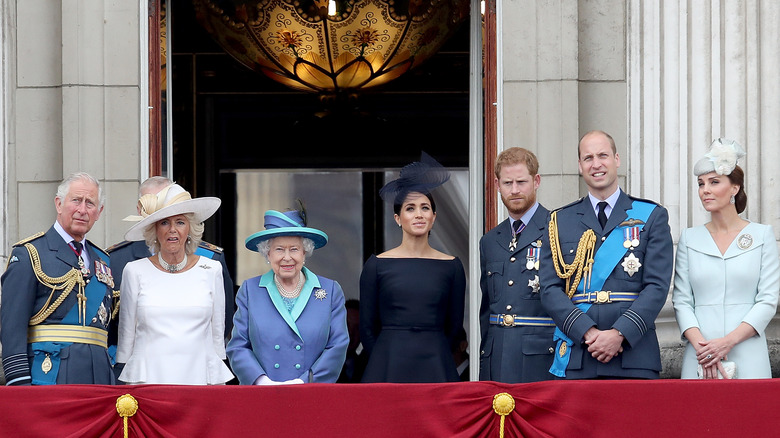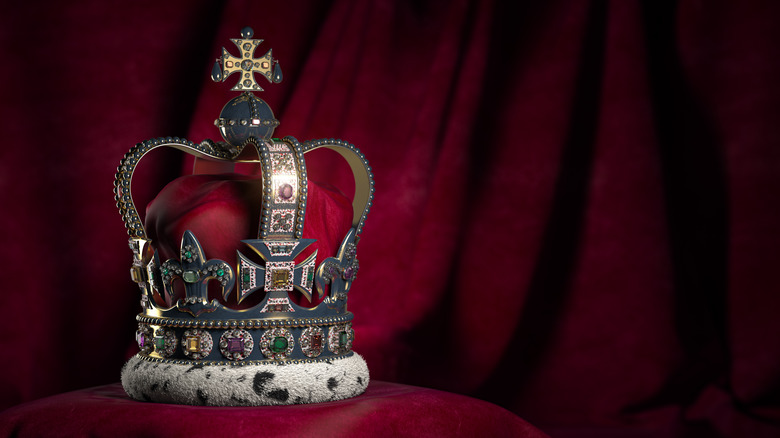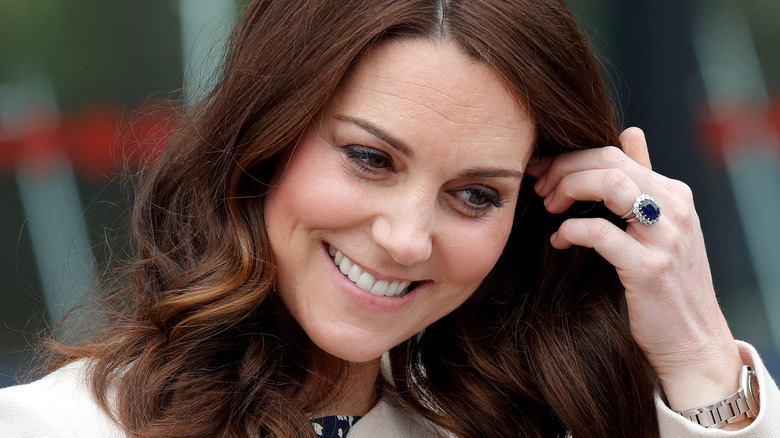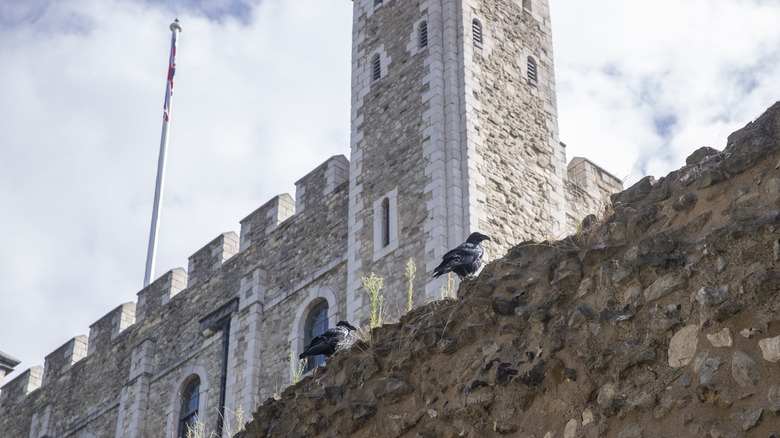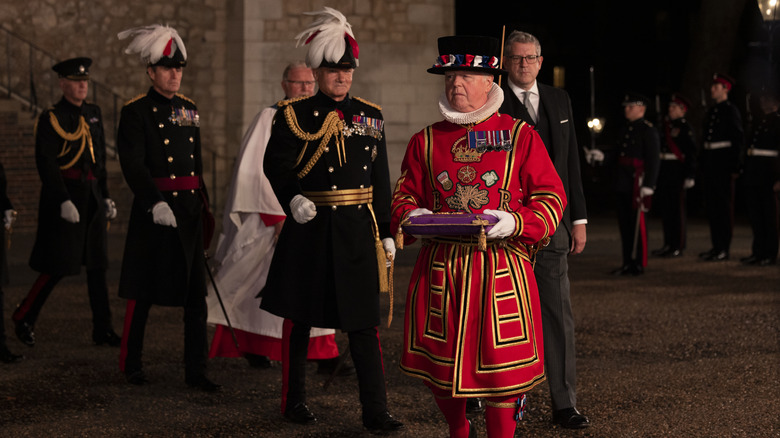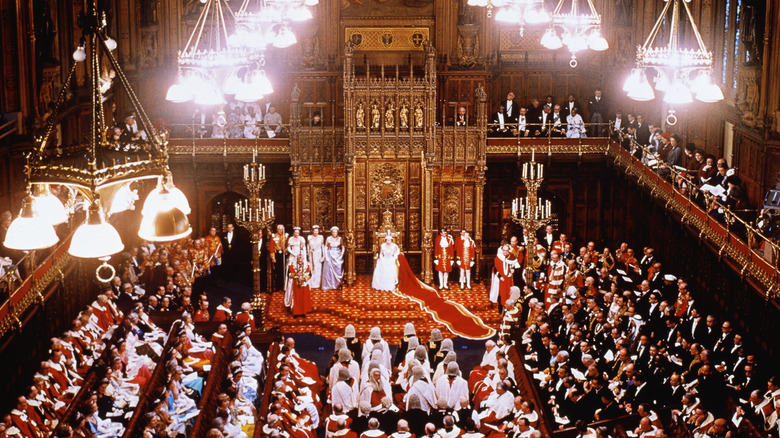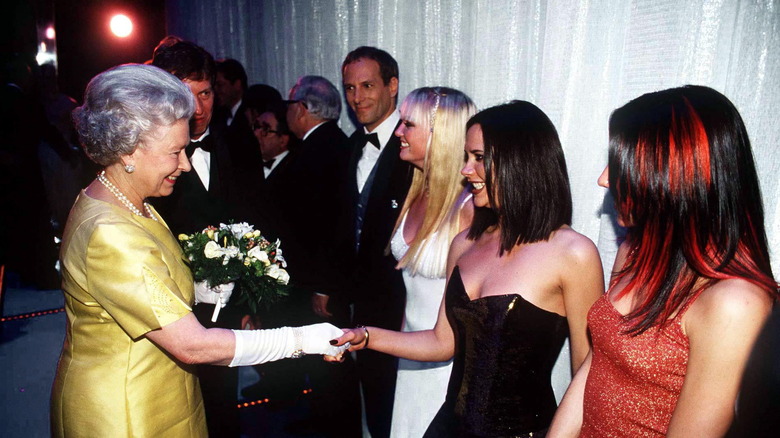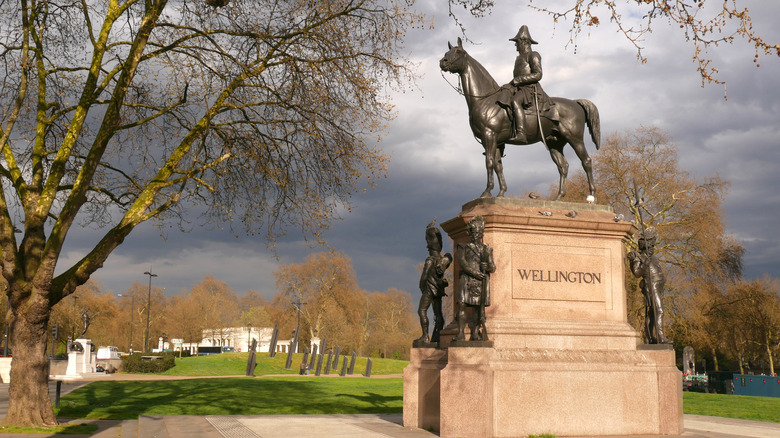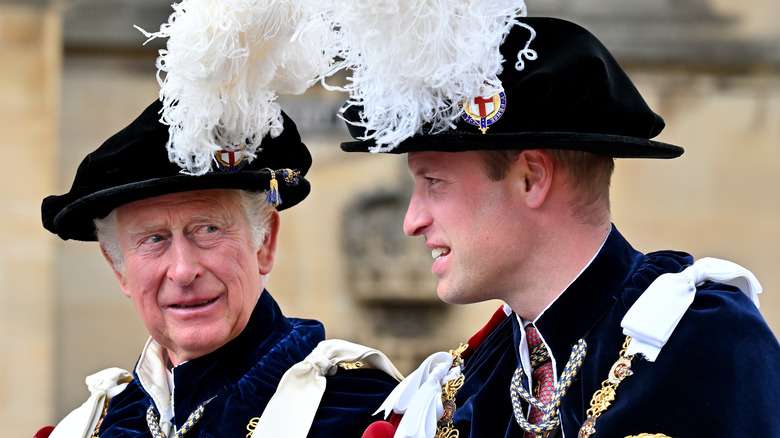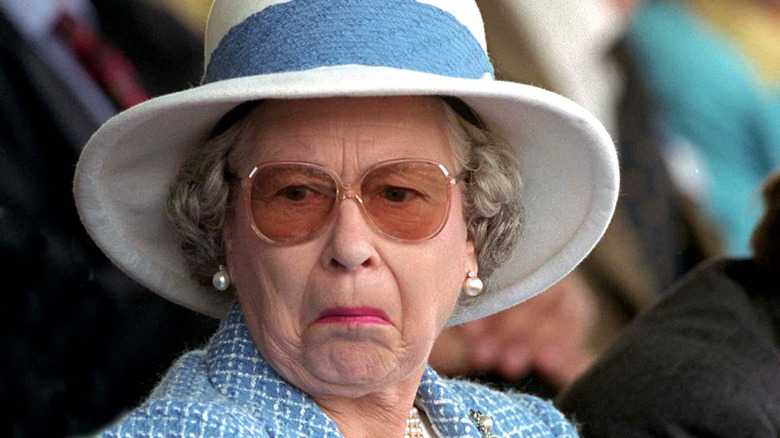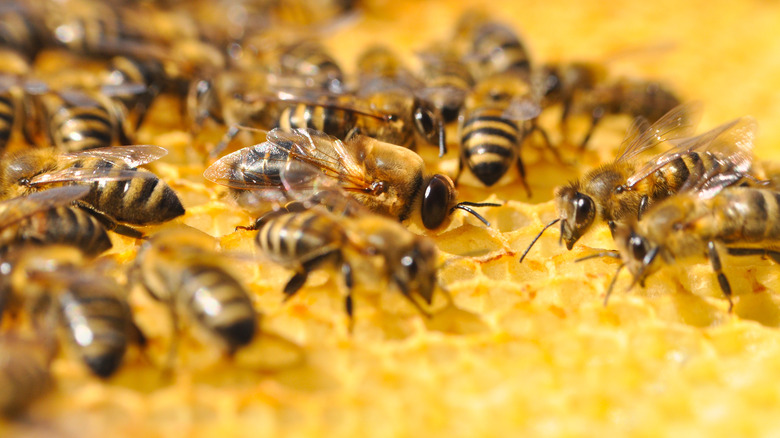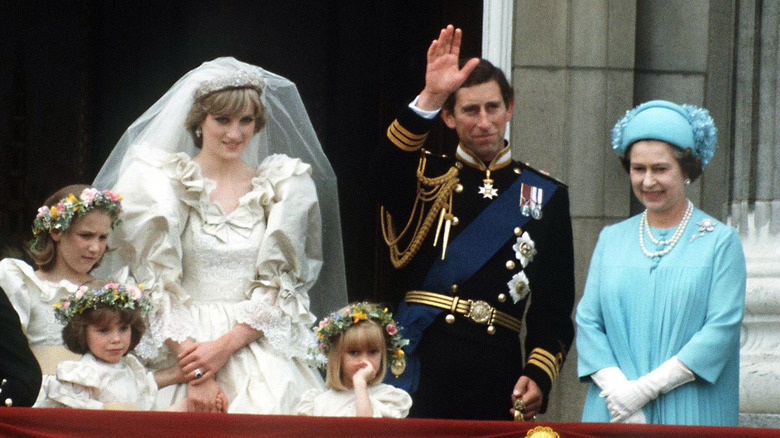The Royal Family's Strangest Superstitions
While it's no secret that Britain's monarchy is steeped in tradition, it's also true that when it comes to royalty, there can be a fine line between tradition and superstition. In fact, everything from royal protocol to ancient rituals to ceremonial costumes have some sort of deeper symbolic meaning dating back hundreds of years. As a result, the royal family is something of a living, breathing museum exhibit.
Living one's life according to a rulebook written several centuries ago is understandably weird, and it could certainly do a number on someone's pysche — for examples, take a spin through Prince Harry's memoir, "Spare." Given all those old traditions that govern royal behavior, it shouldn't be surprising that royals are prone to superstition.
With that in mind, read on for a look at the royal family's strangest superstitions.
Any mishaps on coronation day will doom a monarch's reign
A monarch's coronation is a major occasion in Britain — particularly since there was a 70-year gap between the coronations of Queen Elizabeth II and King Charles III. The history of the coronation ceremony, in fact, can be traced back more than a thousand years and is rife with symbolism and ritual.
There's also a big superstition attached to the ceremony. Monarchs are advised to take extreme caution in order to avoid any mishaps on the day of the coronation; should something go off-course on the big day, according to royal lore, the result will be a royal reign destined to fail. Discussing the coronation of the queen at age 27, Anthony Geffen — who had interviewed the queen for a documentary about her coronation — told The Times 2Arts (via the Express) how fortunate Elizabeth was that hers had gone off without a hitch, given her age and inexperience. "She was just 27 when she was crowned and there is a strong tradition in the history of the English coronation that anything goes wrong it is seen as an ill omen," he explained.
While there was indeed a lot that could have gone south at the young queen's coronation, Charles carried an extra 50 years' worth of baggage to his own ceremony; history will judge how well Charles' reign will stack up to that of his mom.
Royal gems are believed to have 'mystical powers'
Another suspicion prevalent among royalty involves precious gems. "Royal jewellery has shone with gemstones that possess 'Mystical Powers' since the Middle Ages," jeweler Steven Baker told the Express. He ought to know: His company provided Princess Diana's sapphire engagement ring — which was passed down to Prince Harry (and then given to Prince William) and now sits on the finger of Princess Kate. "Mainly sapphires are renowned for strengthening fidelity and commitment as well as bringing stability and prosperity to the financial situation," Baker explained, noting that was precisely why Queen Victoria — arguably as superstitious a royal as there ever has been — wore a humungous sapphire on the day of her wedding.
Another royal jewel supposedly imbued with supernatural powers is the legendary Koh-i-noor diamond, an ancient gem mined in India that sits in the crown traditionally worn by a queen (who's not the monarch) at a coronation. Royal lore claims that the diamond is cursed — but only if it's worn by the monarch, which is why it wound up on the queen's crown.
The last person to wear the crown containing the Koh-i-noor diamond was the Queen Mother; Queen Camilla, however, decided not to follow suit, just to be on the safe side. "It's the nearest thing to the ring of power in 'Lord of the Rings.' Whenever it goes, it stirs up anger, greed, murder and bloodshed!" historian William Dalrymple told NPR.
Ravens must keep calling the Tower of London home
Anyone who's ever visited the famed Tower of London may have noticed that the place is home to multiple ravens. That is not a random occurrence. For centuries, the tower has been inhabited by a single flock — technically known as an unkindness — of ravens. The practice of keeping ravens at the Tower of London dates back to Charles II, who ruled Britain during the 1600s. According to legend, it was Charles II who first ordered ravens be kept there, leading to a longstanding superstition that the crown would fall, the tower itself would crumble, and great misfortune would beset the country if the ravens were to ever leave.
The number of ravens is very specific: six. While that number has varied over the years, during World War II, Prime Minister Winston Churchill was dismayed to discover the number of ravens had dipped down to just one. With a war to win, Churchill leaned into the superstition and issued a decree that there should never be less than six ravens housed at the Tower of London at any given time.
The ravens' role isn't just based on superstition and ceremony: While WWII raged and London was under siege by the Nazis' aerial Blitz, the ravens served as spotters, on the lookout for planes. As the Evening Standard pointed out, the ravens have come to be known as "guardians of the tower," patrolling the area within the gates.
A 700-year-old ceremony is performed each night at the Tower of London
Ravens aren't the only existing remnants of ancient superstition on display at the Tower of London. The London landmark — which has served a lot of purposes over the years, from torture chamber to royal mint to fortress housing the crown jewels — is home to a superstition-based ceremony that takes place each day.
The Ceremony of the Keys is an arcane ritual dating back to the 14th century, in which the tower gates are locked and unlocked on a daily basis. As legend has it, during his reign in the 1300s, King Edward II strolled into the tower one night, managing to make it inside without anyone stopping him. Apoplectic about the massive lapse in security, the ticked-off king had the Constable of the Tower, Edward de la Beche, locked up for failing his duties so severely. Edward also issued an iron-clad edict that stands to this day: the tower gates are to be locked each night at sunset and unlocked each morning at sunrise.
These days, the locking-and-unlocking ritual — performed by staffers outfitted in traditional garb — is more of a tourist attraction than security procedure. "Halt! Who goes there," cries a sentry, with a Yeoman Warder (a.k.a. Beefeater) responding, "The keys." The sentry asks, "Whose keys," with the response given, "King Charles' keys." The sentry then replies, "Pass then, all's well."
The reason the royals take a member of parliament as their hostage
Each year prior to the opening of Parliament, a Yeomen of the Guard performs a ceremonial search of the cellars beneath the Palace of Westminster, commemorating the 1605 "Gunpowder Plot" that attempted to assassinate King James I.
This is followed by one of the monarchy's most shocking rituals: a kidnapping, which not only goes unpunished but is actually encouraged. This is no garden-variety abduction, mind you, but a ritualistic re-enactment built around a core of superstition, in which a member of parliament is ceremonially taken as a hostage in Buckingham Palace while the monarch attends the opening of Parliament. The hostage is held throughout the duration and is only released upon the monarch's safe return to the palace. This superstition is meant to ensure continuing harmony between the Crown and the House of Commons, so as not to repeat what happened in 1649 — when King Charles I's volatile and antagonistic relationship with Parliament led to a civil war that resulted in his beheading after being found guilty of treason.
"And from that point on, the monarch has refused to come to the Houses of Parliament without having a Member of Parliament 'taken hostage' for the peace of mind of the monarch," explained MP James Morris, who served as 2022's ceremonial hostage.
Monarchs believed their 'royal touch' could heal the sick
While kings and queens throughout Europe believed they had healing powers, the notion was introduced in Britain by Edward the Confessor in the 11th century. According to the Royal College of Physicians, the king believed that anyone afflicted with a glandular condition that had been nicknamed "the King's Evil" would be cured by his touch.
More than 500 years later, Charles I reintroduced the practice during the 1600s, supposedly using his magic touch to heal the sick — who each received a commemorative coin (which would often be passed onto their heirs when the king's touch invariably failed to cure them). The practice died out during the reign of William III — who dismissed it as a "silly superstition" — but returned in the 1700s courtesy of Queen Anne. While King Charles III hasn't publicly professed a belief in the healing power of his touch, who's to say whether or not he may actually believe that to be yet another perk of being the King of England?
The annual Waterloo Ceremony is steeped in tradition and superstition
In addition to make-believe hostage-taking, counting ravens, and avoiding cursed jewelry, superstition also underlies the annual Waterloo Ceremony. Each year on June 18, to mark the anniversary of the Battle of Waterloo, the Duke of Wellington pays a visit to Windsor Castle as the star attraction in a ceremony in which he pays the rent on his ancestral home, Stratfield Saye House, which has been home to each successive Duke of Wellington since 1817. These days, the rent is paid by the current title-holder, Arthur Valerian Wellesley, eighth Duke of Wellington.
The rent, however, is entirely symbolic, and no money is actually forked over. Instead, the duke presents the monarch with a special French flag made of silk (a new one is made each year) to honor Britain's victory over France in that short but bloody war. At the time, the Duke of Wellington — who led the British forces to victory — was presented with the estate as a thank-you gift from the Crown for defeating Napoleon's army.
While there's no logical reason for this ceremony to continue taking place year after year, what would happen if it were suddenly to stop? Exactly! Which is why, so long as there's still a British monarchy, it presumably never will.
The superstitious reason why royal heirs can never fly together
One of the stranger — yet oddly common-sense — royal superstitions has resulted in a rule that two direct heirs to the throne are never allowed to travel together, particularly by air. While the rule itself reeks of superstation, the underlying reason is fairly obvious — if the plane carrying both heirs were to crash, the line of succession would be muddied when the current monarch shuffles off this mortal coil. That's why King Charles and Prince William are barred from traveling together, as are William and his firstborn son, Prince George.
Of course, this is one of those royal rules that tends to get routinely ignored. As PopSugar pointed out, Prince William and Princess Kate have skirted the advice repeatedly, with their son Prince George regularly accompanying them on trips requiring air travel.
Then again, it's not technically a directive but more of a guideline — one that has been left entirely to the monarch's discretion. "While there is no official rule on this," a Buckingham Palace official told the Mirror in 2014, "it is something that the queen has the final say on."
Here's why you'll never see a royal eat a sandwich without the corners cut off
There are several royal superstitions involving food. Members of the royal family, for example, refuse to eat oysters and other types of shellfish, both for superstitious reasons but also, supposedly, due to concerns over gastrointestinal illness resulting from consuming a dodgy clam.
Another odd food superstition that the royals buy into has to do with sandwiches. Graham Newbould — who once served as royal chef for both King Charles and Queen Elizabeth — revealed that it is strictly forbidden to serve a royal any sandwich that hasn't had the corners cut off. As Newbould explained in the 2002 television documentary "Secrets of the Royal Documentary" (via MyLondon), there was a big and potentially existential superstition underlying sandwiches without pointy corners. "The royals never have square sandwiches because tradition has it that anyone presenting them with pointed-edged food is trying to overthrow the throne of England," he explained.
When it comes to which particular sandwiches the royals demand having the corners cut from, that varies from royal to royal. For the late Queen Elizabeth, her hands-down favorite was a simple jam sandwich. On his YouTube channel, Darren McGrady — former personal chef to the queen since childhood — said she enjoyed "jam pennies," consisting of bread, butter, and jam, with the sandwiches cut into circles that are the approximate size of a vintage British penny (via Outlook).
Someone had to break the news of the queen's death to the royal bees
Among the many royal possessions of King Charles are bees — like, his very own hives, kept in Buckingham Palace as part of a tradition that dates back centuries. The royal bees are passed down from monarch to monarch and were inherited by Charles upon the death of Queen Elizabeth — and when the queen died, the royal beekeeper initiated a rare ceremony to break the news to the bees.
According to the Daily Mail, palace beekeeper John Chapple visited the beehives, located at both Buckingham Palace and Clarence House, where he tied black ribbons into small bows and affixed them to the hives. Then, using a soft and hushed tone, he let the bees know that their mistress, the queen, had passed on, but they now had a new master — King Charles. In completion of the ritual, Chapple encouraged the bees to treat their new master well by producing lots of honey.
As the Daily Mail noted, the ceremony stems from an ancient superstition that held the bees would cease producing honey — or possibly abandon the hive or even die — if they weren't informed of the change of royal ownership. That superstition, in fact, isn't necessarily confined to just royal bees. "It's a very old and well-established tradition, but not something that's very well-known," Mark Norman, author of "Telling the Bees and Other Customs: The Folklore of Rural Crafts," told The New York Times.
Did the queen curse her children's marriages because of what she wore to their weddings?
While Queen Elizabeth and Prince Philip were married for 73 years until his death in 2021, lengthy marriages like that were not in the cards for all of her children — at least not their first marriages. However, a superstitious theory has emerged that the reason why those marriages didn't last had to do with the outfits the queen wore to those weddings.
The queen wore a blue-colored dress for the wedding of Charles and Diana Spencer. She also wore blue when attending the nuptials of Prince Andrew and Sarah Ferguson. In addition, Queen Elizabeth wore blue for the wedding of her sister, Princess Margaret, to Antony Armstrong-Jones, and once again attired herself in blue for the wedding of daughter Princess Anne to Capt. Mark Phillips.
Given the fate of those marriages, a superstition has developed that the queen wearing blue to a wedding will automatically curse it. Cases in point: Charles and Diana divorced after 15 years, Andrew and Sarah after six, Princess Margaret after 18, and Princess Anne after 15.
